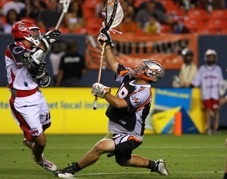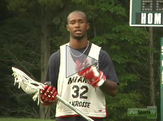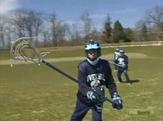PlaySportsTV Lacrosse
Jesse Schwartzman on Lacrosse Goalies Defending Fastbreaks

Jesse Schwartzman
An outnumbered lacrosse defense can halt the offense
By Craig Haley
PlaySportsTV Managing Editor
Jesse Schwartzman describes playing lacrosse goalie as being a coach on the field, but to help his Major League Lacrosse team stop fastbreaks he has to be like a puppet master.
When the offensive team outnumbers the defense in transition, it’s the goalie’s job to help his defensemen stay in a tight formation, almost as if they’re connected by a string. “When one moves, the others move,” Schwartzman says.
That is how you play winning transitional defense, the Denver Outlaws goalie says.
“You want to keep it packed in tight,” Schwartzman recommends, “and if they shoot the ball you want them to shoot the ball from outside. Don’t give up an easy one.”
A boys’ lacrosse defense wants to slow down the fastbreak and give its middies time to get back and create an even side. What has helped make Schwartzman an MLL All-Star, and two-time most outstanding player of the NCAA Division I Final Four, where his Johns Hopkins squads won national titles in 2005 and ’07, is excellent communication skills. When defending transition, he is responsible for directing his defenders into formation.
He’s doing this because a boys’ lacrosse defense that is outnumbered must rely on more than instinct, it needs strategy to squash offensive shooting space.
“Defending transition, it doesn’t matter how many people the other team has, it’s all about how many people your team has,” Schwartzman says. “If you have three, you get into kind of a triangle; four people (get) into a box; five people into like five on a dice (an X); and six people you’re even up. But 4-on-3, 5-on-3, 6-on-3, it doesn’t matter as long you communicate the number of people you have, and what kind of break it is, whether it’s a fast break, a slow break, where the ball is coming from, and you have to dedicate who’s the first, who’s the second, who’s the third slot. You’re talking non-stop the whole time.”
Whichever defender is on the ball should call this out to his teammates so they fall into their defensive spots. He can try for a disciplined poke check to force a bad pass or dropped ball, but doesn’t want to try for many checks which could free up more open space for the offensive players.
The defensive responsibilities shift as the ball moves across the field. At all times, the lacrosse goalie is cutting down shooting angles.
“You’re really trying to make the offense make one more pass and make one more pass and, hopefully, they will mess the pass up and drop it or turn the ball over,” Schwartzman says, “or they will give us more time to recover back to the defensive end.
“It’s just important to stay tight and stay true to your concept.”
Popular Videos in Major League Lacrosse
-
Girls' Lacrosse Drills & Tips Video Library Over 70 Videos!

-
Boys' Lacrosse Drills & Tips Video Library Over 100 Videos!

-
Coaching Youth Lacrosse:
Beginner & Intermediate Over 50 Videos!
-
Wall Ball Essentials Over 20 Videos!

-
Boys' Lacrosse Practice Plans: Ages 7-10



